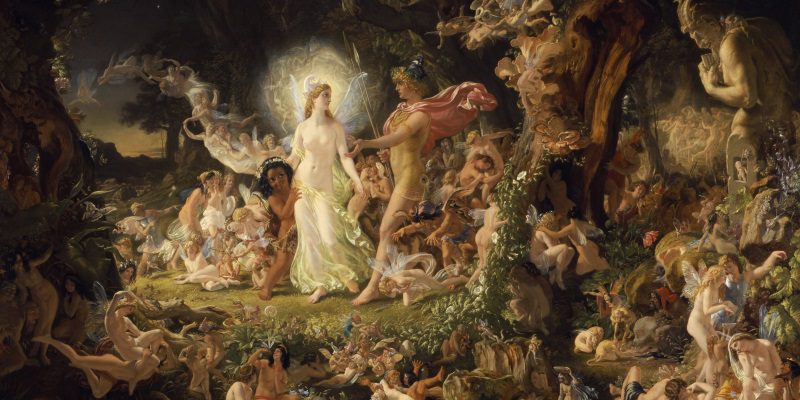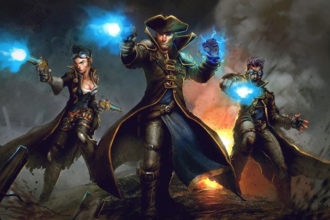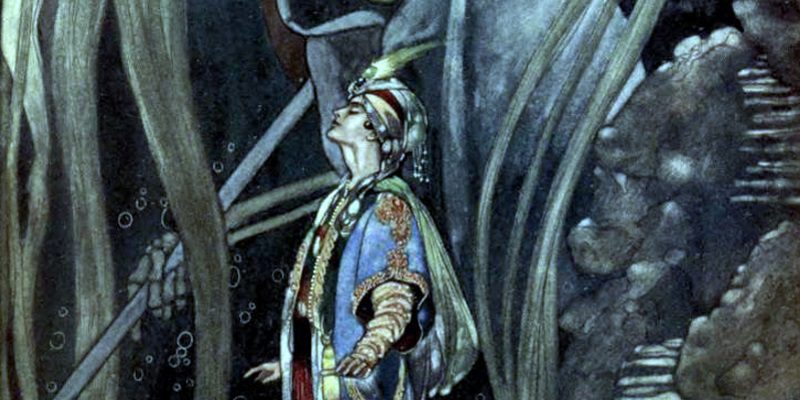Archfey Patrons

I’ve covered a lot of elements of the fey in the course of this series. Today I want to talk about one of the main reasons that we care about them in the first place: warlocks take them as patrons (and some paladins swear Ancient oaths to them). But there’s only one kind of Patron – that is, all Archfey warlocks have the same Patron powers, even though the Archfey themselves are as different as Summer and Winter. That has always sat a bit oddly with me, so in this article I’ll be talking about some kinds of Archfey and the ways each of them is a bit different.
Fey Chivalry | Fey Huntsmen and Leashed Terrors | Faerie Tales: Naiads, Pixies, and Sprites for 5e | A Visit to the Shadowfell – Shadar-Kai & More | In a Goblin Market | Fey of the Elder Starlight | Fey Enchanters and Their Lairs | Treasures of a Fey Market | Archfey Patrons
The Seelie Queen
More often than not in fiction, one finds that the Seelie and Unseelie Courts both have queens as their strongest figures. In my own view, the Seelie Queen is the “default” Archfey patron – Fey Presence is spot on for her and Misty Escape is as traditional for D&D fey as any one power can be at this point (thanks, 4e!). I have a lot of issues with the immunity from Beguiling Defenses, though at least you’re on the hook for ten warlock levels to get that. With Dark Delirium, I envision the Seelie Queen pushing the charmed condition more than frightened, but a single-target really serious crowd control is pretty great (except for the ubiquity of charmed/frightened immunity).
The Archfey Expanded Spells are likewise pretty appropriate to the Seelie Queen, or at least close enough that I’m taking the convenient path and treating them as default. So that I’m not totally ducking content creation for the Seelie Queen, though, here’s a new invocation for her warlocks.
The Queen’s Decorum
Requires Archfey Patron: Seelie Queen
When you cast a spell that imposes the charmed or frightened effect, or you use a class or subclass feature that imposes the charmed or frightened effect, and all targets succeed their saving throws, you may give the effect your Concentration. As long as you maintain your Concentration, you may use this spell or feature again until at least one creature fails its saving throw and becomes charmed or frightened. Once you use this feature, you may not do so again until you complete a long rest.
The Queen of Air and Darkness (the Unseelie Queen)
I have always loved the title “Queen of Air and Darkness,” so let’s see if the dear old dame needs any tarting up to differentiate her from her rival. Fey Presence and Dark Delirium still seem good to me, though I’m sure the Unseelie Court pushes the frightened condition more than charmed. (Not to the exclusion of the other – after all, every kind of manipulation has its place.) Misty Escape isn’t bad, but a more aggressive defense might be called for here. Beguiling Defenses is likewise not bad, but the sort of judo-style turning of force back against the attacker isn’t really the Unseelie style.
In place of Misty Escape, how about:
Air and Darkness
Beginning at 6th level, you vanish in a puff of mist in response to harm, and prepare for a deadly retribution. When you take damage from a creature’s attack or spell, you may spend your reaction to turn invisible until the end of your next turn. The first time you deal damage to the creature that triggered this reaction before the end of your next turn, you deal 2d6 additional damage of the same type to that creature. Edited to Add: Once you use this feature, you must complete a short or long rest before you may do so again.
In place of Beguiling Defenses, how about:
Reign of Terror
Beginning at 10th level, your patron teaches you how to rise above fear and spread it among your enemies. As long as one enemy that you can see is frightened, you suppress the effects of the frightened condition on yourself. You can still gain the frightened condition, but you ignore its effects, including effects that only work on frightened targets.
While at least one enemy that you can see is frightened of you, you may use a bonus action to force its nearest ally that can see it to succeed a Charisma saving throw against your warlock spell save DC or become frightened of you for 1 minute. A creature that fails this saving throw may attempt a new saving throw at the end of each of its turns, and ends the frightened condition on a success. Once you use this feature, you must complete a short or long rest before you may do so again.
Finally, the spell list – misdirection is good, but malice aforethought is better. Dissonant whispers replaces faerie fire, pass without trace replaces calm emotions, and spirit guardians (necrotic version only) replaces plant growth.
The Silver Knight
The Archfey that I’m calling the Silver Knight is less universal a figure than some others, but he features prominently in my own campaign, and maybe he’ll be of interest to you as well. He is the mightiest warrior hero of the Seelie Court, and lesser fey knights (and some paladins of the Oath of the Ancients) emulate him as much as they can. His silver sword cleaves through lycanthropes and fiends, and his shining armor and shield dazzle his enemies.
Because even the Seelie should have a dark side (word to the Wise: “no Archfey is truly trustworthy” is the first great lesson), the Silver Knight is the kind of Patron that places a low value on your personal survival. He suffers grave wounds when he goes into battle, and restoring his strength so that he can aid you always costs something you don’t want to sacrifice. If it were easy, he – and you, his protégé – would not be heroes.
Even Blade Pact warlocks can’t relate to him that much without multiclassing, and… you know what, let’s not have the conversation about warlock multiclassing right now. (Short-short version: if your solution to a class’s problems is to multiclass, you’ve proven the problem rather than solving it.) I’ll want him to support the Pact of the Blade in one way, and other Pacts in some other way. Fey Presence is not completely unsuited to the Silver Knight, but to get what I want out of this Patron, I need the changes to kick in as early as possible.
The Silver Prince’s Armaments
At 1st level when you choose the Silver Prince as your Patron, you gain proficiency in medium armor and shields. If you are a Blade Pact warlock, you also gain proficiency in heavy armor. If you have any other Pact, you gain proficiency in one martial weapon.
Argent Shield
Starting at 6th level, when an ally within 60 feet is hit by an attack, you vanish in a puff of mist and teleport to an open space adjacent to both the attacker and your ally. Using the original attack roll, the attack resolves as if you were the target. You reduce the damage that you take from this attack by 1d6 per point of proficiency bonus that you have. If there is no open space adjacent to both your ally and the attacker, you cannot use this feature. Once you use this feature, you cannot do so again until you complete a short or long rest.
I’ll accept Beguiling Defenses on a kind of… Captain Carrot Ironfoundersson line of reasoning (someone tries to put one over on him, and he turns the tables through raw charisma and purity of intent). Dark Delirium is even more of a stretch, but I’m pointedly not changing all of the features.
For the Expanded Spell List, heroism replaces sleep, warding bond might replaces phantasmal force, and crusader’s mantle replaces blink.
The Lord of the Hunt
The Silver Knight’s opposite number in the Unseelie Court, the Lord of the Hunt is an accomplished combatant, though more given to stealth, inspiring fear, and the hunt than glory in open combat. Fey huntsmen and leashed terorrs are, of course, his chief servants. The sliver of good in this cruel and terrifying force of nature is that he lavishes gifts and blessings on those who truly best his huntsmen and terrors.
Where the Silver Knight had me giving the warlock fighter-like features, the Lord of the Hunt calls for ranger themes. If you can explain to me why rangers of earlier editions had to be goodly without referencing Aragorn in some way, I’d be happy to hear it, because I expect plenty of rangers are just as into the Most Dangerous Game just like the Lord of the Hunt is.
The Lord of the Hunt’s Prey
At 1st level when you choose the Lord of the Hunt as your Patron, you gain proficiency in Survival, and you add 1d6 to the result of Wisdom (Perception) and Wisdom (Survival) checks to find a creature currently affected by a hex you cast.
I’m basically fine with Misty Escape and Dark Delirium for the Lord of the Hunt. Reign of Terror is a better fit for him than Beguiling Defenses, though for slightly different reasons than the Queen of Air and Darkness.
For his Expanded Spell list, beast sense replaces calm emotions (he doesn’t want calm emotions ever, if he can help it!), Mordenkainen’s faithful hound replaces greater invisibility (because… faithful hound, for cryin’ out loud), and tree stride… ugh, this is hard. Dominate person and seeming are both incredibly appropriate for the Lord of the Hunt. Screw it, as far as I’m concerned, tree stride is just a third spell option at 5th level. If I ever publish this, I’ll make the hard decision then!
The Good Fellow
Gentles, do not reprehend:
If you pardon, we will mend:
And, as I am an honest Puck,
If we have unearned luck
Now to ‘scape the serpent’s tongue,
We will make amends ere long;
Else the Puck a liar call;
So, good night unto you all.
Give me your hands, if we be friends,
And Robin shall restore amends.
There are a lot more Archfey archetypes I’d like to cover with this treatment, but there is a merry wanderer outside my window that promises me no peace until I include him. He is the jester and the knave within the Seelie Court, and (given other legends) I wouldn’t be at all surprised to discover that he is Unseelie through and through, but bound in service to the Seelie Queen and her consort.
Puck loves the chaos that a warlock could cause in enemy ranks with Fey Presence, but he’s mostly not all that charming or frightening (except as an elaborate trick, and… well, let the warlock have illusions for that). Misty Escape is fine, as is Beguiling Defenses… but I think Dark Delirium might have to go. I’ll be playing on bardic and roguish themes here, with a particular eye toward the Jester archetype that Unearthed Arcana gave us.
Puckish Tricks
At 1st level when you choose the Good Fellow as your Patron, you gain proficiency in Sleight of Hand and thieves’ tools. You never use somatic or material components to cast hex, and your verbal components can be masked as conversation or jokes. You may choose to learn vicious mockery as one of your cantrips.
When you make a Dexterity (Sleight of Hand) or Charisma (Deception) check against a creature currently affected by a hex that you cast, add 1d6 to your check result.
The Grand Jest, or: “Lord, What Fools these Mortals Be!”
Starting at 14th level, you can reveal the grand jest that you have played on everyone. All creatures within 60 feet of you roll Wisdom saving throws against your warlock spell save DC. Take the total number of failed saving throws and halve it, rounding fractions up. You and the DM each switch the positions of that number of pairs of creatures within range, alternating turns. Neither you nor the DM may switch back a change that the other has made. (Creatures may not choose to fail this saving throw.) You may switch the positions of creatures that succeeded their saving throws, but doing so costs two of your position changes rather than one. (If both members of a switching pair succeeded their saving throws, that costs three position changes rather than one.) Once you use this feature, you may not do so again until you complete a long rest.
Finally, the Expanded Spells List – Puck should really have faerie fire (it’s the spotlight in his show!), sleep (because… Midsummer Night’s Dream), and Tasha’s hideous laughter. Fine, screw it, give them all three as far as I’m concerned. They still cost Spells Known, so it’s not that much help! Detect thoughts replaces calm emotions, and freedom of movement replaces dominate beast. There’s at least a good argument for mislead replacing dominate person, but mislead is probably too corner-case for a warlock’s very tight Spells Known budget.
Design Notes
I hope my design thinking is fairly clear throughout, on a thematic level if not a balance level. Some of the Fey Presence replacements are a lot better than Fey Presence, but Fey Presence just… isn’t very good. Look at them in the light of Dark One’s Blessing, maybe. The Silver Prince’s Armaments could probably use a small bump in power as well, but most of the things that come to mind for me aren’t small. It bears further thought, anyway. (Or did you not know that, in blogging, you’re always looking at rough drafts?)
Credit for mechanical concept of the Argent Shield goes to Colin McLaughlin. Used here with permission.
The Grand Jest is by far my favorite replacement feature, because it opens the floor to so much chaos. You think it’s zany in combat? Try using it in an inn at night, and suddenly you have a sex comedy. (Where the hell is Tim? And there the hell was Tim.) I cut the DM in on the action because even the best trickster can’t get exactly what he wants out of his efforts.
The Queen’s Decorum is a minor fix for the crippling weakness of a mind-control-focused warlock. Unlike most spells and effects, things that charm or frighten usually do nothing on a successful saving throw, because the game doesn’t have a concept of half-charmed or half-frightened. Instead, I’ve judged that the Queen’s charms are never rebuffed for long, as long as she maintains decorum (Concentration). It’s a 4e-style Reliable tag, with limitations. It does nothing to solve the ubiquity of immunity to charmed and frightened, but I can only move the heavens or the earth with a single invocation – doing both would be OP.
I’ve really pushed hex in the Lord of the Hunt’s Prey and Puckish Tricks. It’s the closest thing to a Bardic Inspiration-style mechanic. I assume that for most warlock builds, it’s just capitalizing on what you were doing anyway. Also, reasons to hex people in less-than-lethal situations might be a positive.
Next time in the fey series, I’ll cover several more Archfey that could be suitable Patrons for warlocks – the Thornweaver, the Sea Hag, the Night Collector, and others as they come to me.



